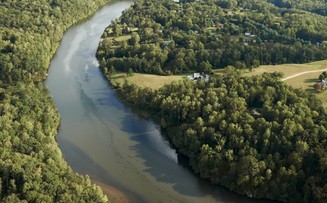"To interpret Virginia's natural heritage within a global context in ways that are relevant to all citizens of the Commonwealth." - Virginia Museum of Natural History Mission
As the state's museum of natural history serving the entire Commonwealth and beyond, the Virginia Museum of Natural History is home to award-winning exhibits, ground-breaking scientific research and collections, and innovative educational programs for all ages. The museum celebrated the opening of its new world-class facility in March 2007, drawing visitors from all 50 states and 20 countries.
The Museum's message is simple: understanding natural history is the first step toward meeting the challenges of preserving and managing natural resources in the future. From the vacationer watching birds on the shores of the Chesapeake to the garden enthusiast in Alexandria, each and every Virginian directly benefits from the ongoing research and collections programs at the Virginia Museum of Natural History.
The Harvest Foundation Great Hall
The Harvest Foundation of the Piedmont Great Hall welcomes visitors with a vast assortment of fascinating displays. Visitors are greeted by the enormous skeleton of Allosaurus dinosaur, while a skeleton of a 14 million-year-old baleen whale hangs beneath a vaulted ceiling of skylights. Windows offer a peek into the museum's active laboratories where researchers and volunteers work, and award-winning displays and graphic presentations greet visitors at every turn.
Uncovering Virginia
The permanent exhibit gallery Uncovering Virginia features recreations of six research sites in Virginia where VMNH scientists and their colleagues have worked or are working. There is a range of geographic locations around the Commonwealth that span a broad interval of time from 700 million years ago to 300 years ago. At each exhibit, there is: a recreation of the site as it is today; a lab experience where visitors can examine fossil or archaeological evidence and use the same tools as scientists to interpret that evidence; and video animation that brings to life the animals and plants that were alive at that time and in at that place.
The Lee & George W. Lester, II How Nature Works Gallery
The Lee & George W. Lester, II How Nature Works gallery demonstrates how energy from within the Earth's crust and energy from the sun have shaped the Earth as we know it today. Visitors view and interact with the exhibits to better understand the magnificent forces and processes that have helped create the world today.
The How Nature Works: Rocks exhibit includes dramatic landscape models that reveal how the world is shaped by geological forces that are themselves powered by the enormous energy deep within the planet.
A striking display of plants and animals fill the How Nature Works: Life exhibit. Visitors learn that almost all living things on Earth depend, directly or indirectly, on the sun as their energy source.
The Hahn Hall of Biodiversity
The Hahn Hall of Biodiversity opened to the public in August 2010. The Hahn Hall of Biodiversity features the spectacular African mammal collections of Dr. Thomas Marshall Hahn Jr., President Emeritus of Virginia Tech. Dr. Hahn generously donated his extensive collections to VMNH for the enjoyment and education of countless future visitors of all ages.
Fossil Overlook
The museum's Fossil Overlook is a new prehistoric life exhibit that includes a variety of fossils, detailed models, casts, and interactive multimedia programs for visitors of all ages.
Museum Info
The Museum, located on Route 58 Business at 21 Starling Avenue in Martinsville, is open Monday through Saturday, 9 a.m. to 5 p.m. Between May 27 and September 2, 2012, the Museum will also be open to the public on Sundays from 1 to 5 p.m.
For more information about planning your visit, admission, current exhibits, education programs, and a calendar of upcoming events please visit the Museum's website here.
Comment
You Might Also Like
Watershed Geology & Mining Facilities
Map produced by National Geographic Maps
U.S. Army Women's Museum
The U.S. Army Women’s Museum, located at Fort Lee, Virginia, is the only museum in the world dedicated to Army women. The Museum honors women's contributions to the Army from the Revolutionary War to the present, telling their stories with …
U.S. Army Quartermaster Museum
I am Quartermaster. My story is enfolded in the history of this nation. Sustainer of Armies The Quartermaster Museum, located at Fort Lee, Virginia, offers a glimpse into the Army's oldest logistic branch. For more than two centuries, from …
The Ghost Fleet
The Ghost Fleet is not as haunted as it sounds, but still potentially dangerous. It is the nickname given to the James River Reserve Fleet-nearly a hundred ships kept for storage between Hog Island and Burwell Bay. After WWII, about 800 boats were …
Henricus Historical Park
Take a step back in time to the "Commonwealth of Henrico". This outdoor living history museum represents the various aspects of early life in Virginia's second settlement.
Flowerdew Hundred Plantation
The site of the first windmill in British America, Flowerdew has seen it's share of history as the commonwealth took shape. This land has been attacked, shelled, burned, divided, sold, and reunited. General Ulysses Grant once crossed the James on a …

















